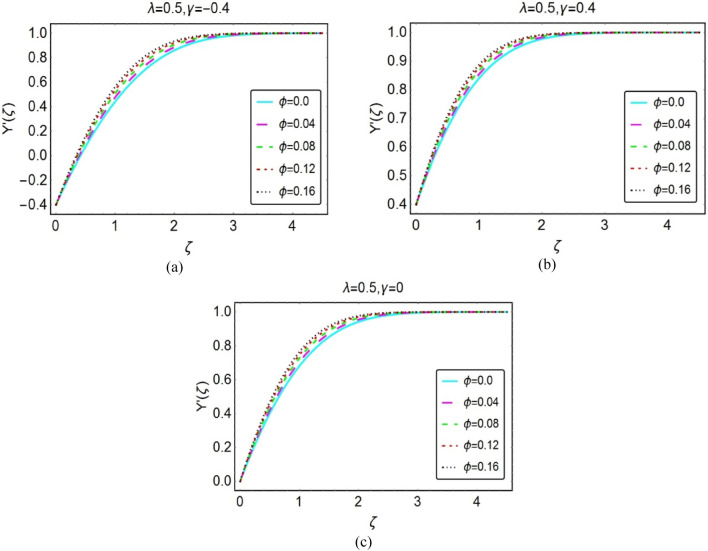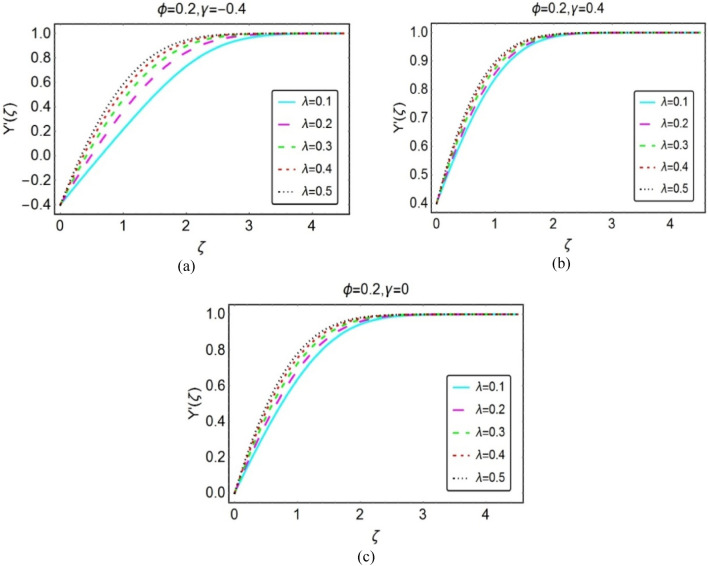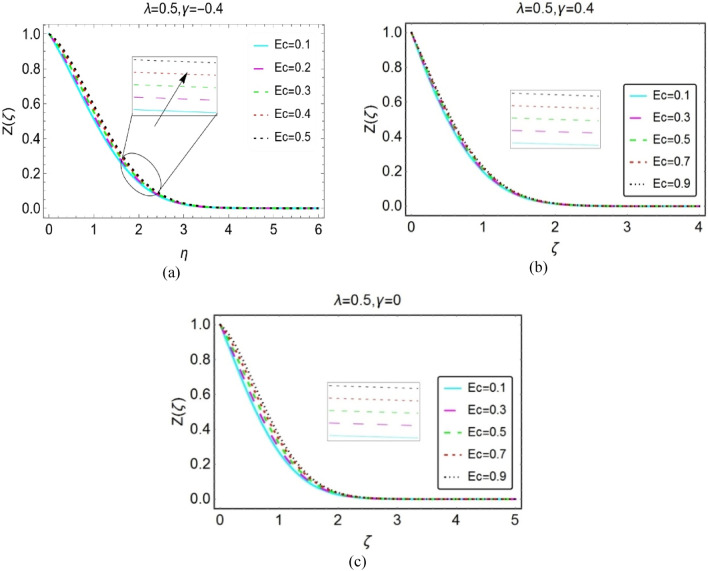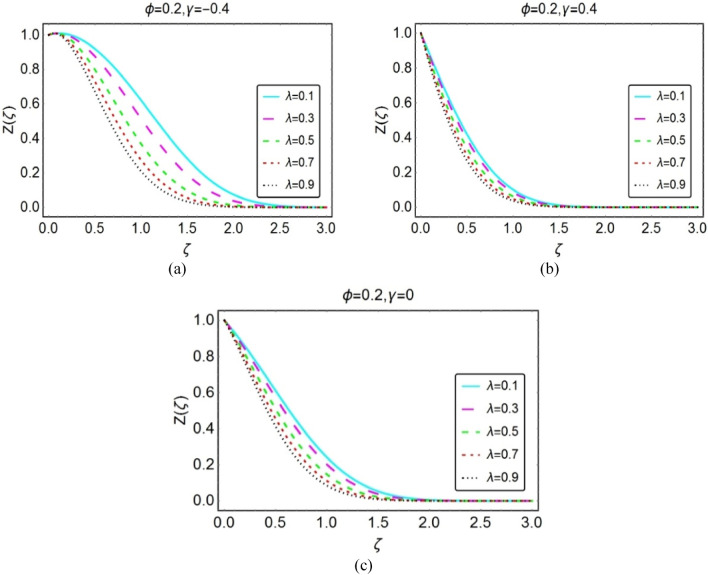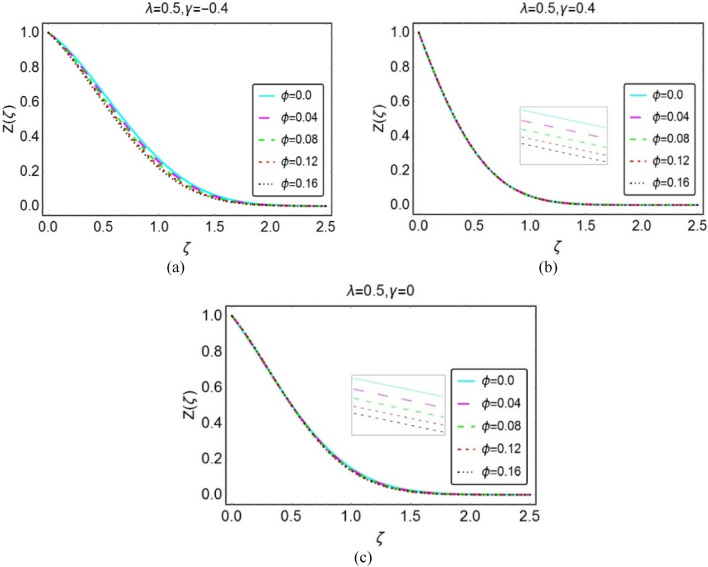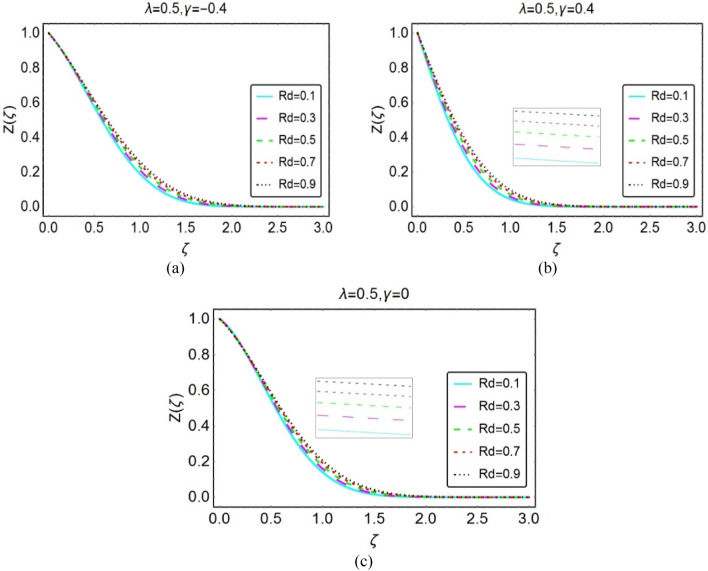Abstract
The analysis of nanofluids heat transfer over a wedge is very important due to their wider applications in applied thermal engineering, chemical engineering and biomedical engineering etc. Therefore, aim of the study is to explore the heat transport in nanofluid over a wedge (Falkner Skan flow) under viscous dissipation and thermal radiation over a wedge. The proper model formulation is carried out via similarity relations and empirical correlations of the nanofluids. After successful model transformation, numerical scheme (RK technique along with shooting technique) applied and furnished the results over the desired domain under varying effects of preemenant flow parameters. The results revealed that the velocity rises for opposing () and assisting () flows against and significant contribution of Ec and imposed thermal radiations (Rd number) observed in thermal performance of the nanofluid. The temperature declines by strengthen and optimum decrement is noted for opposing flow. Finally, a comparison is provided for various values of () with previously published work under certain restrictions and found an excellent agreement.
Subject terms: Engineering, Mathematics and computing, Nanoscience and technology
Introduction
Due to wide application of nanofluids in a series of industrial and technological processes, the research of nanofluids is of great significance and cannot be ignored. Nanofluids are defined as fluids containing nano-sized particles, called nanoparticles. The nanofluid produces a colloidal suspension of tiny particles in the regular liquid. Water, ethylene glycol etc. are typical choices for base fluids. The analysis of magneto hydrodynamic Falkner Skan is one of the major and basic motives due to its uses in various industries and practical situation. Especially, traditional flow of Non-Newtonian and Newtonian fluids over a wedge presently attains fame among the researches. The forerunner work in this period was done in1. Later on, it was improved by Rajagopal2. They investigated the dynamics of non-Newtonian liquid flowing over a wedge.
The researchers concentrated on the dynamics of liquids under certain flow conditions. The similarity solutions for wedge flow modeled by improving the strength of Pr examined in3. They developed the particular model by taking convective heat transport and higher Pr values. The behaviour of nanofluid characteristics under the impacts of Lorentz forces discussed in4. They modeled the problem over a wedge under free convection scenario. They furnished the results by altering the governing quantities and proved a detailed discussion. The study of wall stresses and temperature behaviour in incompressible fluid over a permeable wedge is reported in5. El-Dabe et al.6 explored the analysis of boundary layer flow of non-newtonian fluid and found hidden impacts of Lorentz forces for thermal and mass transportation. They conducted the numerical analysis of the model and then compared the outcomes with some existing relevant literature. The characteristics of casson liquid due to symmetric wedge are discussed in7. They concluded that the temperature of the fluid elevated due to higher prandtl effects and the walls shear stresses improved by strengthening the casson parameter.
The significant investigation of thermal transportation under combined convection and MHD over a permeable stretchable wedge is explored by Su et al.8. To improve thermal performance of the fluid, they plugged the influences of thermal radiations and resistive heating the constitutive correlations and then performed mathematical study and decorated the pictorial results against the pertinent governing quantities. The alterations in the fluid behaviour due to non-stationary wedge are detected in9. They developed the model for micropolar liquid under certain physical scenario and then discussed the dynamics of the model via graphs. Porosity of the surface imperatively alters the fluid behaviour. Therefore, Rashidi et al.10 organized the analysis of viscoelastic liquid over a porous wedge. In addition, they emerged the effects of thermal radiations in the model and examined the fascinating results for the fluid behaviour over the desired region. Some imperative investigations of the liquid flowing over or between the geometries by contemplating various flow conditions are presented in11–17 and the studies reported they’re in and tackled by implementing various mathematical techniques.
Thermal enhancement in the nanoliquid saturated by aluminum alloys is presented in18. They established the model under various conditions and pictorially discussed the dynamics of the liquid. In 2017, the analysis of Ferro fluid is reported by considering the properties of Lorentz forces and thermal radiation19,20. Recently, in 2017, Khan et al.21 described the study of three-dimensional squeezed in the existence of γ-Aluminum as a nanoparticle and used water, ethylene and glycol as base fluids.
Interaction of ferromagnetic nanomaterial with species under the action of chemical species report by Tahir et al.22. The problem developed over a stretchable cylinder and discussed the dynamics of the fluids for various values of the permanent flow quantities. Cattaneo Christov heat flux model is a potential area of research and imperatively changes the behaviour of fluid temperature. Therefore, the study of thermal transport in micropolar fluid by inducing CC model is examined by Ahmad et al.23 in 2021. Numerical treatment of a mathematical model for heat transport in a square duct is conducted by Fuzhang et al.24. Some significant recent studies regarding micropolar fluid under temperature dependent characteristics, Carbon nanotubes under bi-stratification and FVM examined in25–27. The investigation of thermal radiations and their contribution in the heat transfer attained much interest of the researcher community in recent time. Therefore, Acharya et al.28 reported the temperature behaviour under in radiated nanofluid by using thermal conductance model comprising the influences of nanolayer and diameter. Other recent studies for heat transfer under solid–liquid interfacial layer, solar energy and ferro fluid flow slippery geometry were described in29–31.
From the investigation of the above cited literature, the following research gap and research questions are found that will be addressed in this study:
The heat transport by inducing thermal conductivity model (including Brownian motion, freezing temperature and molecular diameter) under novel effects of thermal radiation and viscous dissipation for opposing and assisting flow is reported over a wedge so far.
What will be the behaviour of nanofluids velocity over a wedge for assisting/opposing and stationary cases?
What will be the significant contribution of thermal radiations and viscous dissipation in the thermal performance of the nanofluids?
Numerical technique will be adopted for mathematical treatment of the model.
Is the study will be valid after imposing certain restriction on the model?
Mathematical modelling
Consider the flow of water suspended by Aluminum oxide nanoparticles. It is assumed that the flow is viscous and incompressible, the particular nanofluid flow taken over the wedge geometry. The wedge is situated in Cartesian coordinate system. The velocity at the wedge is and the velocity of the nanofluid at free stream is denoted by , here and are invariable.
Moreover here , where is called Hartree pressure gradient parameter corresponding to , where is the total wedge angle. The temperature at the wedge surface is in which free surface temperature is Physical configuration of the flow is pictured in Fig. 1.
Figure 1.
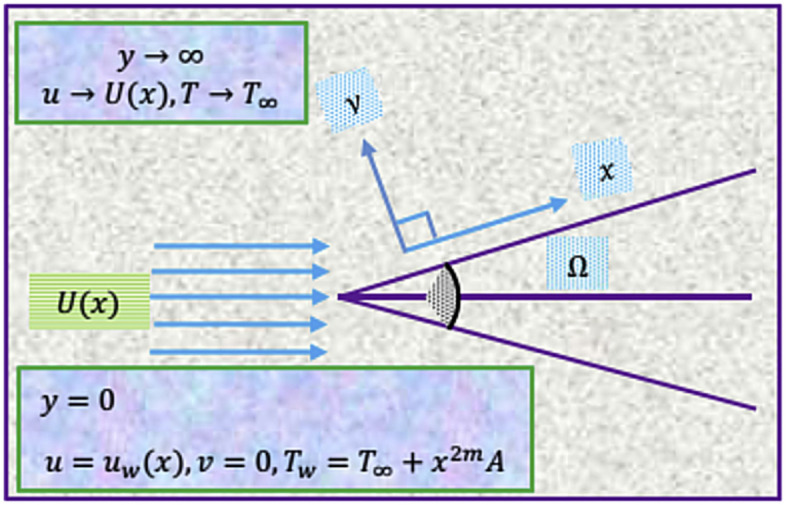
Nanofluid flow scenario.
In the light of above-mentioned assumptions, PDE’s representing the flow nanofluid in the presence of Hartree pressure parameter in the momentum equation and the radiative heat flux incorporated in energy equation are as follows32,33:
| 1 |
| 2 |
| 3 |
The conditions at the wedge surface ()
| 4 |
The conditions at the free stream ():
| 5 |
The following similarity variables and stream function support the flow model32,33:
| 6 |
Since
So
The derivative of w.r.t
| 7 |
The derivative of w.r.t
| 8 |
Second derivative of w.r.t
| 9 |
Differentiating w.r.t
| 10 |
Derivative of w.r.t
| 11 |
Second derivative of w.r.t
| 12 |
The following empirical correlations for nanoliquid utilized34,35:
| 13 |
| 14 |
Thermal conductivity ratio of the particular nanofluid problem already calculated34,35:
| 15 |
| 16 |
where is described as:
| 17 |
In Eq. (3), represents the Brownian velocity of nanoparticles and is calculated as:
| 18 |
where, is the Boltzmann Constant. is the mean path of fluid particles. is the molecular34,35 diameter of water:
| 19 |
The value of is defined as
| 20 |
| 21 |
By using the derivatives calculated in Eqs. (7) to (12)
| 22 |
| 23 |
Here,
Further, the conditions reduced as:
At the wedge surface;
| 24 |
Far from the surface:
| 25 |
where, (moving wedge parameter), (Prandtl number) (Eckert number) and (Radiation number).
Thermophysical values of the hosting liquid and nanoparticles are given as36 (Table 1).
Table 1.
Thermophysical values of the particles and hist liquid.
| Host liquid/nanoparticles | Thermal expansion coefficient (K−1) | Thermal conductivity (Wm−1 K−1) | Heat capacity (J kg−1 K−1) | Density (kg m−3) | Pr |
|---|---|---|---|---|---|
| Water | 0.60 | 4182 | 998.3 | 6.96 | |
| Al2O3 | 40 | 765 | 3970 | – |
Mathematical investigation of the model
For mathematical investigation of the model, the following procedure is adopted:
| 26 |
and
| 27 |
| 28 |
Finally, the following version is attained:
| 29 |
With conditions:
| 30 |
Graphical results with discussion
Analysis of results
This section devoted to analyze the behaviour of the nanofluid velocity and temperature field against the preemenant parameters for feasible range.
Discussion of results
The velocity field
Figures 2 and 3 organized to inspect the behaviour of nanofluid velocity over opposing, assisting and stationary wedge cases, respectively. These results furnished for varying and . The results revealed that the nanofluid velocity drops for both and . However, rapid decays inspected for opposing flow situation. Physically, when fluid and wedge move in reciprocal direction, the frictional force becomes dominant in the fluid layer adjacent to the wedge surface. As a consequent, the velocity decays; whereas; for assisting flow situation, these variations are quite inconsequential. These results highlighted in Figs. 2 and 3, respectively.
Figure 2.
Impacts of on for (a) opposing (b) assisting and (c) static case.
Figure 3.
Impacts of on for (a) opposing (b) assisting and (c) static case.
The temperature field
This section is organized to analyze the temperature behaviour by varying the flow quantities Eckert number, , and thermal radiation number (Rd). For this, Figs. 4, 5, 6, and 7 under varying parameters effects.
Figure 4.
Impacts of Eckert number on for (a) opposing (b) assisting and (c) static case.
Figure 5.
Impacts of on for (a) opposing (b) assisting and (c) static case.
Figure 6.
Impacts of on for (a) opposing (b) assisting and (c) static case.
Figure 7.
Impacts of on for (a) opposing (b) assisting and (c) static case.
Figure 4a–c decorated to investigate the temperature behaviour against multiple values of Ec for opposing (), assisting () and stationary wedge (), respectively. It is noticed that Eckert number potentially contributed in the heat transfer of the nanofluid. The significant rise in the temperature is observed for all the cases. Physically, induction of viscous dissipation in the energy equation, improves internal energy of the fluid; consequently, the fluid temperature upshots. The temperature at ambient position of wedge becomes almost inconsequential and asymptotic behaviour is observed.
Figures 5 and 6 highlight the temperature for numerous values of and volume fraction of the nanoparticles , respectively. It is noted that these parameters oppose the nanofluids temperature and optimum decrement is noticed for opposing flow cases. Physically, the fluid velocity reduces when wedge and fluid accelerate in opposite direction. As a result, the fluid motion decays and colloisions between the particles declines which lead to rapid declines in the temperature.
The potential contribution of thermal radiation in the temperature field of the nanofluid is decorated in Fig. 7 for three cases (opposing, assisting and stationary wedge). The results revealed that the temperature upsurges in the presence of thermal radiations. Physically, thermal radiations induct energy in the fluid due to which this energy transfers from one to other particles and consequently overall the nanofluid temperature rises. These results highlighted in Fig. 7a–c, respectively.
Validation of the study
As, the conventional fluid model can be obtained from the nanofluid model by setting . The current study is now validated with previously reported studies by restricting our model for certain flow parameters (). The comparison revealed that the results obtained in the study are in excellent agreement with existing literaure37,38 (Table 2).
Table 2.
Validation of the study for under certain conditions on the flow parameters.
Concluding remarks
The study of nanofluid is reported over a wedge for assisting/opposing flow situations. The flow problem properly modeled by engaging similarity equations and nanofluids effective correlations. The resultant model is treated numerically and furnished the results for assisting/opposing flow. The study revealed that:
The velocity field rises by increasing the values of .
The temperature field of the nanofluid significantly upshots for more dissipative fluid and maximum increment is observed for opposing flow case.
In the presence of thermal radiations, temperature of the nanofluid enhances for both assisting and opposing cases.
The rapid drops in the temperature field are noticed against the parameter for considered cases.
A comparative analysis under certain restrictions is provided with previously published and found an excellent agreement.
List of symbols
- [u*, v*]
Velocity components
Temperature
Velocity at the surface
Main stream velocity
Ambient temperature
Stream function
Dimensionless variable
Dimensionless temperature
Effective density
Density of particles and host fluid
Dynamic viscosity
Dynamic viscosity of the host fluid
Heat capacity of the nanofluid
Heat capacity of the particles
Heat capacity of the fluid
Nanofluids thermal conductance
Particles thermal conductance
Host fluid thermal conductance
Brownian velocity of nanoparticles
Boltzmann constant
Molecular diameter
Dimensionless velocity
Dimensionless temperature
- Pr
Prandtl number
- Ec
Eckert number
Wedge parameter
- Rd
Thermal radiation number
Author contributions
A: developed a physical model and formulated the problem. R.M.: solved the problem and computed results. I.H.: Discussed and examined the results. Z.R.: computations and numerical simulations. Computed results in Table 2 and the present work is compared with published work in literature. I.K.: modified the formulations and obtained the results in section “Graphical results with discussion” of the revised manuscript. Discussed the results base on new computations. M.A.: helped in software coding and making corrections in revision with authors’ responses. Included an updated version of the Table which includes thermophysical properties of nanofluid and materials.
Data availability
The authors declared no additional data for this manuscript.
Competing interests
The authors declare no competing interests.
Footnotes
Publisher's note
Springer Nature remains neutral with regard to jurisdictional claims in published maps and institutional affiliations.
Contributor Information
Adnan, Email: adnan_abbasi89@yahoo.com.
Ziaur Rehman, Email: z.rehman@mu.edu.sa.
Ilyas Khan, Email: i.said@mu.edu.sa.
Mulugeta Andualem, Email: mulugetaandualem4@gmail.com.
References
- 1.Falkner VM, Skan SW. Some approximate solutions of the boundary layer equations. Philos. Mag. 1931;12:865–896. doi: 10.1080/14786443109461870. [DOI] [Google Scholar]
- 2.Rajagopal KR, Gupta ASA. A note on Falkner–Skan flow of non-Newtonian fluids. Non-linear Mech. 1983;18:313–320. doi: 10.1016/0020-7462(83)90028-8. [DOI] [Google Scholar]
- 3.Lin HT, Lin LK. Similarity solutions for laminar forced convection heat transfer from wedges to fluid of any prandtl number. Heat Mass Transf. 1987;30:1111–1118. doi: 10.1016/0017-9310(87)90041-X. [DOI] [Google Scholar]
- 4.Watanable T, Pop I. Magnetohydrodynamic free covection flow over a wedge in the presence of transverse magnetic field. Int. Commun. Heat Mass Transf. 1993;20:871–881. doi: 10.1016/0735-1933(93)90040-3. [DOI] [Google Scholar]
- 5.Koh J, Hartnett J. Skin friction and heat transfer for incompressible laminar flow over porous wedge with suction and variable wall temperature. Int. J. Heat Tansf. 1961;2:185–198. doi: 10.1016/0017-9310(61)90088-6. [DOI] [Google Scholar]
- 6.El-dabe GARREK. Numerical solution of MHD boundary layer flow of non Newtonian Casson fluid on moving wedge with heat and mass transfer and induced magnetic field. J. Appl. Math. Phys. 2015;3:649–663. doi: 10.4236/jamp.2015.36078. [DOI] [Google Scholar]
- 7.Mukhopadhyay S, Mondal IC, Chamkha AJ. Casson fluid flow and heat transfer past a symmetric wedge. Heat Transf. Res. 2013;42:665–675. doi: 10.1002/htj.21065. [DOI] [Google Scholar]
- 8.Su X, Zheng L, Zhang J. MHD mixed convective heat transfer over a permiable stretching wedge with thermal radiation and Ohmic heating. Chem. Eng. Sci. 2012;78:1–8. doi: 10.1016/j.ces.2012.04.026. [DOI] [Google Scholar]
- 9.Ishak NRA, Pop I. Moving wedge and flat plate in a micropolar fluid. Int. J. Eng. Sci. 2006;44:1225–1236. doi: 10.1016/j.ijengsci.2006.08.005. [DOI] [Google Scholar]
- 10.Rashidi MM, Freidoonimehr N, Rostami B, Hossain M. Mixed convective heat transfer for MHD viscoelastic fluid flow over a porous wedge with thermal radiation. Adv. Mech. Eng. 2014;6:735–740. [Google Scholar]
- 11.Kandasamy R, Raji A, Khamis A. Effects of chemical radiation, heat mass transfer on boundary layer flow over a porous wedge with heat radiation in presence of suction or injection. Theory Appl. Mech. 2006;33:123–148. doi: 10.2298/TAM0602123K. [DOI] [Google Scholar]
- 12.Hussanan A, Anwar M, Ali F, Khan I, Shafie S. Natural convection flow passed on oscillating plate with Newtonian heating. Heat Transf. Res. 2014;45:119–135. doi: 10.1615/HeatTransRes.2013006385. [DOI] [Google Scholar]
- 13.Pal D, Mondal H. Influence of temperature-dependent viscosity and thermal radiation on MHD forced convection over a non-isothermal wedge. Appl. Math. Comput. 2009;212:194–208. [Google Scholar]
- 14.Rahman M, Al-Lawatia M, Eltayeb I. Hydromagnetic slip flow of water based nanofluids passed a wedge with convective surface in presence of heat generation or absorption. Int. J. Therm. Sci. 2012;57:172–182. doi: 10.1016/j.ijthermalsci.2012.02.016. [DOI] [Google Scholar]
- 15.Ullah I, Khan I, Shafie S. Hydromagnetic Falkner–Skan flow of Casson fluid past a moving wedge with heat transfer. Alexandria Eng. J. 2016;55:2139–2148. doi: 10.1016/j.aej.2016.06.023. [DOI] [Google Scholar]
- 16.Aman S, Khan I, Ismail Z, Salleh M. Impacts of gold nano particles on MHD mixed convection poseuille flow of nano particles passing through a porous medium in the presence of thermal radiation, thermal diffusion and chemical reaction. Neural Comput. Appl. 2016;30:1–9. doi: 10.1007/s00521-016-2688-7. [DOI] [PMC free article] [PubMed] [Google Scholar]
- 17.Khalid A, Khan I, Shafie S. Heat transfer in ferrofluid with cylenderical shape nano particles passed a vertical plate with ramped wall temperature embeded in a porous medium. J. Mol. Liquid. 2016;221:1175–1183. doi: 10.1016/j.molliq.2016.06.105. [DOI] [Google Scholar]
- 18.Sandeep N, Sharma PR, Firdows M. Enhanced heat transfer in unsteady magnetohydrodynamic nanofluid flow embeded with alluminium alloy nanoparticles. J. Mol. Liq. 2017;234:50–53. doi: 10.1016/j.molliq.2017.03.051. [DOI] [Google Scholar]
- 19.Sheikholeslami M. Magnetohydrodynamic nanofluid forced convection in a porous lid driven cubic cavity by means of lattice Boltzmann method. J. Mol. Liq. 2017;231:364–374. doi: 10.1016/j.molliq.2017.03.104. [DOI] [Google Scholar]
- 20.Sheikholeslami M. Magnetohydrodynamic nano fluid convective flow in a porous enclosure by means of LBM. Int. J. Heat Mass Transf. 2017;113:796–805. doi: 10.1016/j.ijheatmasstransfer.2017.05.130. [DOI] [Google Scholar]
- 21.Ahemd N, Mohyud-Din ST, Khan U. Numerical investigation for three dimensional squeezing flow of nano fluid in a rotating channel with lower stretching wall suspended by carbon nanotubes. Appl. Therm. Eng. 2017;113:1107–1117. doi: 10.1016/j.applthermaleng.2016.11.104. [DOI] [Google Scholar]
- 22.Tahir H, Khan U, Din A, Chu YM, Muhammad N. Heat transfer in a ferromagnetic chemically reactive species. J. Thermophys. Heat Transf. 2021 doi: 10.2514/1.T6143. [DOI] [Google Scholar]
- 23.Ahmad S, Nadeem S, Muhammad N. Cattaneo–Christov heat flux model for stagnation point flow of micropolar nanofluid toward a nonlinear stretching surface with slip effects. J. Therm. Anal. Calorim. 2021;143:1187–1199. doi: 10.1007/s10973-020-09504-2. [DOI] [Google Scholar]
- 24.Fuzhang W, Ali S, Nadeem S, Muhammad N, Nofal TA. Numerical analysis for the effects of heat transfer in modified square duct with heated obstacle inside it. Int. Commun. Heat Mass Transf. 2021;129:105666. doi: 10.1016/j.icheatmasstransfer.2021.105666. [DOI] [Google Scholar]
- 25.Khan MN, Nadeem S, Muhammad N. Micropolar fluid flow with temperature-dependent transport properties. Heat Transf. 2020;49:1. doi: 10.1002/htj.21726. [DOI] [Google Scholar]
- 26.Ahmad S, Nadeem S, Muhammad N, Issakhov A. Radiative SWCNT and MWCNT nanofluid flow of Falkner–Skan problem with double stratification. Physica A. 2020;547:124054. doi: 10.1016/j.physa.2019.124054. [DOI] [Google Scholar]
- 27.Muhammad N. Finite volume method for simulation of flowing fluid via Open FOAM. Eur. Phys. J. Plus. 2021 doi: 10.1140/epjp/s13360-021-01983-y. [DOI] [Google Scholar]
- 28.Acharya N, Mabood F, Shahzad SA, Badruddin IA. Hydrothermal variations of radiative nanofluid flow by the influence of nanoparticles diameter and nanolayer. Int. Commun. Heat Mass Transfer. 2022;130:105781. doi: 10.1016/j.icheatmasstransfer.2021.105781. [DOI] [Google Scholar]
- 29.Acharya N. Framing the impacts of highly oscillating magnetic field on the ferrofluid flow over a spinning disk considering nanoparticle diameter and solid-liquid interfacial layer. J. Heat Transfer. 2020;142(10):102503. doi: 10.1115/1.4047503. [DOI] [Google Scholar]
- 30.Acharya N. On the flow patterns and thermal behaviour of hybrid nanofluid flow inside a microchannel in presence of radiative solar energy. J. Therm. Anal. Calorim. 2020;141:1425–1442. doi: 10.1007/s10973-019-09111-w. [DOI] [Google Scholar]
- 31.Acharya N. Spectral simulation to investigate the effects of nanoparticle diameter and nanolayer on the ferrofluid flow over a slippery rotating disk in the presence of low oscillating magnetic field. Heat Transfer. 2021;50(6):5951–5981. doi: 10.1002/htj.22157. [DOI] [Google Scholar]
- 32.Ullah KIS. Hydromagnetic Falkner Skan flow of Casson fluid passed over a moving wedge with heat transfer. Alexandria Eng. J. 2016;55:2139–2148. doi: 10.1016/j.aej.2016.06.023. [DOI] [Google Scholar]
- 33.Srinivasacharya MUVK. MHD boundary layer flow of nano fluid passed a wedge. Procedia Eng. 2015;127:1064–1070. doi: 10.1016/j.proeng.2015.11.463. [DOI] [Google Scholar]
- 34.Zaidi SZ, Khan U, Ahmed N, Mohyud-Din ST, Chu YM, Khan I, Nisar KS. Impacts of freezing temperature based thermal conductivity on the heat transfer gradient in nanofluids: Applications for a curved riga surface. Molecules. 2020 doi: 10.3390/molecules25092152. [DOI] [PMC free article] [PubMed] [Google Scholar]
- 35.Khan U, Abbasi A, Ahmed N, Alharbi SO, Noor S, Khan I, Mohyud-Din ST, Khan WA. Modified MHD radiative mixed convective nanofluid flow model with consideration of the impact of freezing temperature and molecular diameter. Symmetry. 2019 doi: 10.3390/sym11060833. [DOI] [Google Scholar]
- 36.Khan U, Ahmed N, Mohyud-Din ST. Surface thermal investigation in water functionalized Al2O3 and γAl2O3 nanomaterials-based nanofluid over a sensor surface. Appl. Nanosci. 2020 doi: 10.1007/s13204-020-01527-3. [DOI] [Google Scholar]
- 37.Watanabe T. Thermal boundary layer over wedge with uniform suction or injection in force flow. Acta Mech. 1990;83:119–126. doi: 10.1007/BF01172973. [DOI] [Google Scholar]
- 38.Ahmed N, Khan U, Mohyud-Din ST, Khan I, Murtaza R, Hussain I, Sherif ESM. A novel investigation and hidden effects of MHD and thermal radiations in viscous dissipative nanofluid flow models. Front. Phys. 2020 doi: 10.3389/fphy.2020.00075. [DOI] [Google Scholar]
Associated Data
This section collects any data citations, data availability statements, or supplementary materials included in this article.
Data Availability Statement
The authors declared no additional data for this manuscript.



